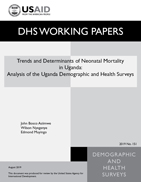- PUBLICATIONS
- JOURNAL ARTICLES
- ORDER PUBLICATIONS
Publications Summary
- Document Type
- Working Papers
- Country(s)
- Uganda
- Language
- English
- Recommended Citation
- Asiimwe, John Bosco, Wilson Nyegenye, and Edmond Muyingo. 2019. Trends and Determinants of Neonatal Mortality in Uganda: Further Analysis of the Demographic and Health Surveys. DHS Working Paper No. 151. Rockville, Maryland, USA: ICF.
- Download Citation
- RIS format / Text format / Endnote format
- Publication Date
- August 2019
- Publication ID
- WP151
Download
 Trends and Determinants of Neonatal Mortality in Uganda: Further Analysis of the Demographic and Health Surveys (PDF, 517K)
Trends and Determinants of Neonatal Mortality in Uganda: Further Analysis of the Demographic and Health Surveys (PDF, 517K)
Download this publication
There is no printed copy available to order.
